[ad_1]
Staphylococcus aureus commonly causes infections in dairy cows, leading to bovine mastitis and lower milk quality. In research published in the journal Small, investigators developed magnetic microrobots that can efficiently bind and isolate S. aureus.
“Microrobots and nanorobots have been around for about a decade,” Martin Pumera, PhD, director of the Center for Advanced Functional Nanorobots in Prague, Czech Republic and lead author of the study, tells Food Quality & Safety. “At our research center, we are interested in bringing up application relevant to human health, animal health, and food safety. So, the isolation of pathogens from milk or removal of biofilm is an important piece in our overall direction.”
The hope with the study was to develop magnetic microrobots based on paramagnetic hybrid microstructures loaded with IgG from rabbit serum that can bind and isolate S. aureus from milk in a concentration of 3.42 104 CFU g−1, the allowable minimum level established by USDA. The magnetic microrobots, deemed “MagRobots” by the investigators, were able to remove S. aureus from milk without impacting other naturally occurring microbes by utilizing paramagnetic microparticles modified with tosyl.
The removal of S. aureus from dairy products currently is a challenge because the bacterium can survive the pasteurization process and the use of antibiotics can compromise the quality of the food. Dr. Pumera notes that the MagRobots offer a promising alternative to current methods of removing bacteria in the dairy product industry. Moreover, this fuel-free system based on magnetic robots does not affect the natural milk microbiota or add any toxic compound resulting from fuel catalysis. This system can be used to isolate and efficiently transport S. aureus
and discriminate it from nontarget bacteria for subsequent identification.Still, Dr. Pumera notes that the experiment was conducted in a lab using expensive commercial reagents. He adds that the cost of the motors can be very low, as the MagRobots are based on Fe3O4 and polymers, and since the MagRobots can enter hard-to-reach places within a milk production plant and operate wirelessly, there’s great promise with the technology. “This research brings microrobotics toward a new frontier—animal veterinary health and safe foods,” Dr. Pumera adds. “Microrobots, due to their size, are able to solve challenges faster than tradition technologies.”
[ad_2]
Source link










